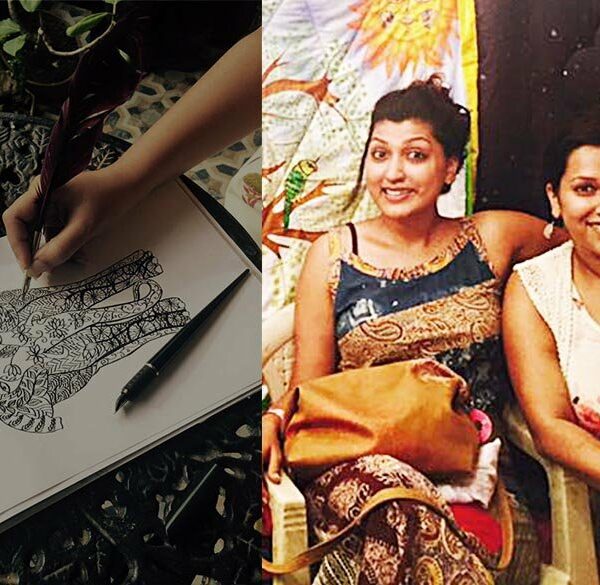A proud owner of the culinary studio ‘Food-E: Culinary Studio’ in Mumbai, Aditi Goel is…
Read More →

A proud owner of the culinary studio ‘Food-E: Culinary Studio’ in Mumbai, Aditi Goel is…
Read More →
“My life was never the same after experiencing a bra-fitting session in New York City,”…
Read More →
The Story begins …. Feministaa speaks to Payal and Priyanka about their journey behind the…
Read More →
After a successful career of 10 years in the corporate world, Charu Srivastava decided to…
Read More →
SkillTree knowledge Consortium was started in 2012 to disseminate knowledge through various mind-sharing avenues. Started…
Read More →
“Men and Women are not equal, they are different’ – With this hypothesis, Fempowerment Women…
Read More →
Almari, started by a young girl named Deepika Reddy is now one of the most…
Read More →
I worked for over 8 years with MNC’s like Ernst & Young and Northern Trust…
Read More →
Ankita Asai was in her final year at IIT Kanpur and she applied to Schlumberger…
Read More →
BonAppetour is a community marketplace that connects travellers with local hosts for unique dining experiences around…
Read More →
A proud owner of the culinary studio ‘Food-E: Culinary Studio’ in Mumbai, Aditi Goel is…
Read More →
“My life was never the same after experiencing a bra-fitting session in New York City,”…
Read More →
The Story begins …. Feministaa speaks to Payal and Priyanka about their journey behind the…
Read More →
After a successful career of 10 years in the corporate world, Charu Srivastava decided to…
Read More →
SkillTree knowledge Consortium was started in 2012 to disseminate knowledge through various mind-sharing avenues. Started…
Read More →
“Men and Women are not equal, they are different’ – With this hypothesis, Fempowerment Women…
Read More →
Almari, started by a young girl named Deepika Reddy is now one of the most…
Read More →
I worked for over 8 years with MNC’s like Ernst & Young and Northern Trust…
Read More →
Ankita Asai was in her final year at IIT Kanpur and she applied to Schlumberger…
Read More →
BonAppetour is a community marketplace that connects travellers with local hosts for unique dining experiences around…
Read More →
A proud owner of the culinary studio ‘Food-E: Culinary Studio’ in Mumbai, Aditi Goel is…
Read More →
“My life was never the same after experiencing a bra-fitting session in New York City,”…
Read More →
The Story begins …. Feministaa speaks to Payal and Priyanka about their journey behind the…
Read More →
After a successful career of 10 years in the corporate world, Charu Srivastava decided to…
Read More →
SkillTree knowledge Consortium was started in 2012 to disseminate knowledge through various mind-sharing avenues. Started…
Read More →
Indians have a unique uneasiness with any talks related to sex. This uneasiness reflects in multiple ways, men’s coercive sexual behavior towards females is one of them. The incidents of rape and associated violence, in public spaces of any city, are parts of this behavior. In addition to such gruesome incidents, there are `milder’ forms of sexual harassment everywhere, and these affect the dignity and freedom of women.
A female academic from Indonesia has recently exclaimed that women from their country have to be very careful about the behavior of Indian and Pakistani men in an international pilgrimage. Hence spirituality or religiosity doesn’t make a difference in such case.
In India, coercive sexual behavior within marriage is a common issue that women face.
Given the general reluctance to divorce, the financial dependence of women on their husbands, and the not-so-enabling social attitude towards female divorcees, it is not surprising if women tolerate even a higher level of sexual violence within the marriage. The social unwillingness to recognize rape within the marriage as a legal crime is a reason behind the severity of this problem.

When we speak about the sexual behavior of men and the problem women are struggling through, we must also consider other aspects of sexual violence. We usually tend to overlook this, because our society is still uneasy to talk about it and even to express their views and desires. Keeping apart the sexual violence, the majority of our society does not have a healthy and composed approach towards SEX.
One manifestation of this unhealthy attitude towards sex is the excessive anxiety in the neighborhood (especially in rural areas, small towns, and apartment complexes) when a man and a woman, who are not married, spend their time together in a closed room. This anxiety is sickening when it leads to different forms of unhealthy moral policing. On the other hand, you may not come across such an anxious behavior in a number of countries – both developed and undeveloped ones.
People in other countries, see the sexual relationship between two consenting adults as a private affair, unlike our country.
Indians, sometimes also showcase their unaccepting behavior in places which places that attract sex tourists. Although, sex-work is tolerated in some parts of our own country. It is controlled in a very non-transparent fashion, which also feeds the trafficking of women and girls at a younger age and that becomes a source of rent for police officials and others.

Our difficulty in dealing with sex manifests in the selection of marital partners too. In a number of developing and developed countries, parents are alright if their son/daughter chooses their partners. This implies that people accept (sometimes implicitly) a certain level of sexual contact before the marriage. On the other hand, the avoidance of love affairs and sexual contact before marriage, especially for women is the fundamental cogitation of the Indian parents.
Indian society is observed to control the female sexuality more than any other country. Although there are some countries that follow India on this path, we shall read about it in the later part of the essay. But why is sex a big deal? Is the teenage/unwanted pregnancy that Indian society is concerned about? Really, because that cannot be an issue and if this is the case then simple and thorough guidance from parents could solve this at the roots! In fact, the share of teenage/unwanted pregnancies is much higher in India, especially due to marriage events of under-aged girls. There could be something else troubling Indians in this regard.
There are other factors that compel men to control women and controlling their sexuality, apparently is the easiest they found! Broadly speaking, there were two patterns in this regard when most people depended on agriculture and related occupations (such as cattle rearing). Wherever it required men to heavy-duty tilling or cattle-rearing or such tasks are important for the survival of households, a higher value was attributed to the male labor, men’s urge to transfer the fruits of that labor which is accumulated in the form of assets to own biological progenies might have led to the control of female sexuality. This was the situation in most parts of the world including India.

Economics also play a significant role – as providing for a family is expensive (assuming the women aren’t the primary breadwinner). Relationships and marriages are an investment of money, time and energy. Sometimes men are understandably skittish while making a commitment if there is any doubt about the wisdom of his investment. Even a hint of unfaithfulness can trigger intense feelings of betrayal and which makes them want to have a control of their partner.
Men’s insecure nature too is a reason why they tend to control women sexually, as it is considered that women, once have a physical relationship with any man will stay devoted to him in any stitch.
However, those geographical areas located closer to the equator had a slightly different pattern. These included parts of South-east Asia, certain African countries and also the Amazonian river basin in the Latin America. In these regions, the basic human survival was based on fruits from trees, tubers, a kind of agriculture which did not require that much tilling, etc. Higher rainfall and richer biodiversity there could facilitate such a livelihood. Hence the basic survival could go on with female labor. Male labor may add some `luxurious’ items to the diet – like a fish from the river or the meat of a wild animal.
In such cases, households wanted to retain female labor or daughters. That was useful for taking care of older parents too. Females would inherit the assets. They would have children through sexual relationships with `partners’ and they need not be life-long husbands. Female sexuality was not controlled that excessively in such social contexts.

This was the situation of ‘pre-modern’ era but how do we explain this situation now? Europe, China, Japan and few other countries were all similar to Indian in term of controlling women’s sexuality, but these countries, however, have developed the differences. Industrialization, urbanization and digitalization have made it possible and enabled the education and employment of women in Europe and North America. All socialist nations had attempted some kind of social engineering by facilitating the mandatory schooling and employment of females. The capitalist development in East Asia focused on the education and employment of girls. Countries in south-east Asia benefitted from the traditional pattern (of valuing female labor at par with that of male) and the economic or industrial development during the second half of the twentieth century.
However, India did not have any of these enabling factors. There was no social engineering or focus on industrialization based on the education and employment of girls. Nearly one out of two workers continues to depend on agriculture for the livelihood. About three out of four females of working age survive as home-makers. Hence India, Pakistan, Afghanistan in South Asia and the Muslim-dominant countries located in the Middle-East and North Africa continue more or less in the same situation with a higher level of control over female sexuality. This is reflecting in the education and work participation of women too.
There is a crucial disabling factor in India which leads to the control of both male and female sexuality.
That is the caste system. The main concern of most Indian parents is to see that their sons and daughters marry within the caste. This cannot be ensured if the selection of a marital partner is left to the younger generation. Hence the sexuality of both men and women are controlled severely before the marriage in India.

All these have led to a situation where the sexual relationship, which should ideally be a normal or simple relaxing affair between two consenting adults, becomes somewhat hideous. Or it becomes part of a highly complicated and intractable moral conundrum. Hence it manifests in many perverse forms. There is excessive curiosity on matters related to sex which is not satiated among growing up boys and girls. The suppressed sexuality comes out in most unpleasant forms whenever people see an opportunity to express it. Indian male behaves like the `untied rooster’ – just a phrase! It may lead to the imposition of male sexuality over women or sustain a perception that the rights of women need not be respected in meeting the sexual needs of the male. This leads to an inadequate recognition of female sexuality.
All these create a situation where an Indian, especially the male, finds somewhat incapable to deal with his sexuality in a comfortable or relaxed way. He becomes either a harasser or a laughing stock in this matter in front of others.
And this needs to stop somewhere, so why not here!
Men need to understand this, women too have their say when it comes to their sexuality and desires as mating partners!
© Feministaa 2024 Media Pvt. Ltd. All rights reserved


